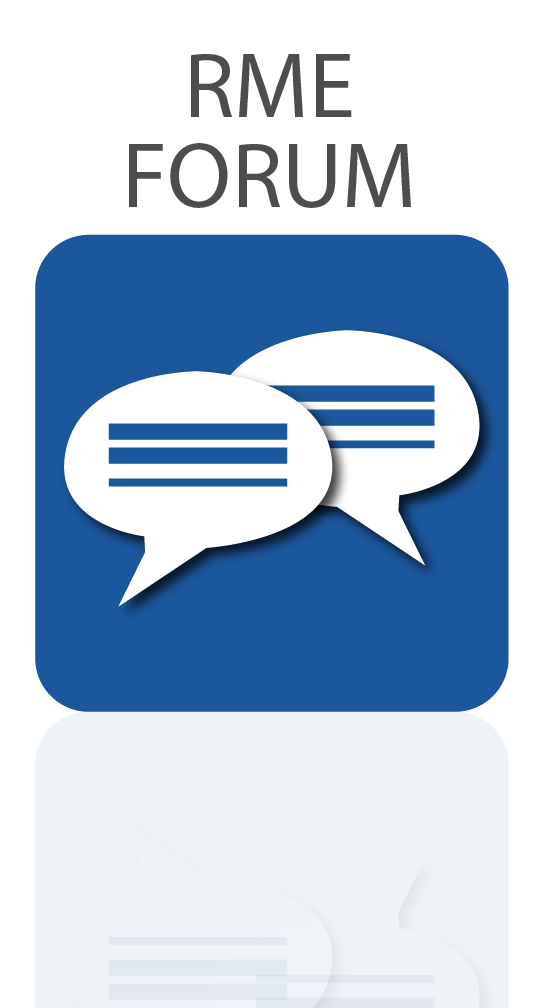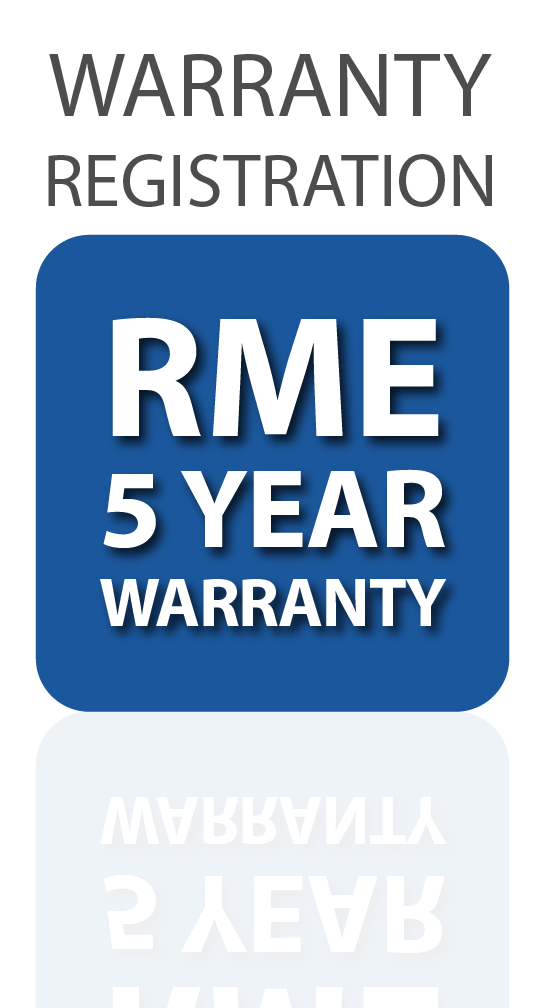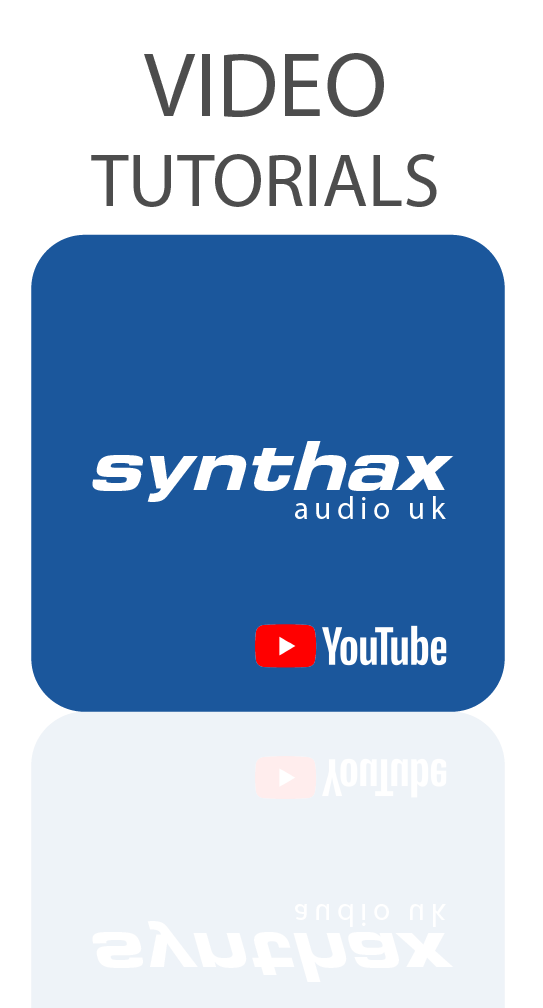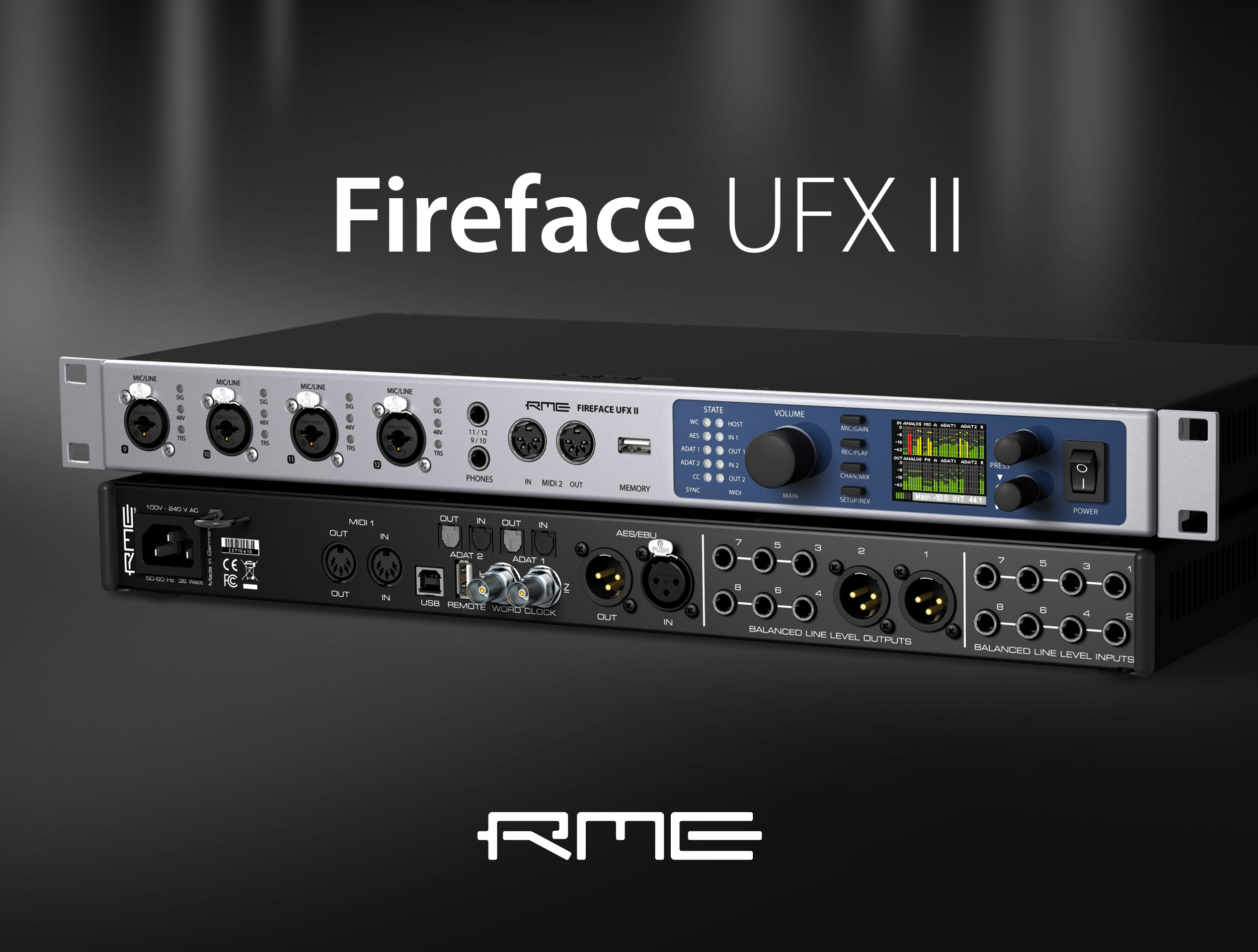 With RME’s announcement that the successor to the highly acclaimed RME Fireface UFX is on the horizon, we take a look at the new RME Fireface UFX II
With RME’s announcement that the successor to the highly acclaimed RME Fireface UFX is on the horizon, we take a look at the new RME Fireface UFX II
RME recently announced the launch of the RME Fireface UFX II audio interface, the successor to the long-standing favourite, the RME Fireface UFX. Released back in 2010, the original Fireface UFX quickly became a mainstay of recording studios and live rigs around world, due to its combination of high-end specs and professional sound. With versatile connectivity, ultra low-latency and rock-solid drivers, equal performance on Mac, PC and Linux, plus the flexibility provided by TotalMix FX, the Fireface UFX has become a firm favourite among sound engineers working in a variety of disciplines.
Fast forward to 2016 and RME launched the RME Fireface UFX+, an 188-channel version of the UFX which has taken the Fireface range to new heights, with the addition of MADI I/O plus USB 3 and Thunderbolt connectivity. Now at Winter NAMM 2017, the design team at RME have unveiled an upgraded version of the original UFX, bringing the same great sound quality and converters of the UFX+ to engineers who don’t require the incredibly high channel count.
Specs and Connectivity
For the UFX II, RME have taken everything that was great about the Fireface UFX and combined it with the company’s most recent research developments. The latest high-end AD/DA converters, optimised analogue I/O circuits, and improved SNR and THD values guarantee the transparent, crystal-clear audio that RME is known for. The preamps have been redesigned, giving you more gain to play with (75dB), and the improved SNR (115 dB RMS unweighted, 118 dBA) ensures you’ll be making super-clean and detailed recordings even when working with quieter sources. On top of this, the two new high-power headphone outputs have also been redesigned, with an output impedance of 2 Ohms providing enough juice to power any pair of headphones regardless of their impedance. The new silver housing also means the Fireface UFX II fits nicely alongside other recent products from the latest range, such as the Fireface 802, Babyface Pro and the new MADIface Pro.
The analogue and digital I/O remains the same as before, with 30 inputs and 30 outputs. The I/O is spread across 12 channels of analogue ins and 12 analogue outs, with the inputs including 4x mic pres and the outputs including 2x headphone outs. The 2x ADAT I/O gives a possibility of further expansion, with up to 32 channels of analogue I/O when connected to an appropriate AD/DA converter, such as the Ferrofish A32. You also have 2 channels of AES/EBU, a popular digital format in TV and film production, or SPDIF, which is used by many digital audio consumer appliances such as HiFi’s, TV’s and games consoles. There’s also 2x MIDI I/O for connecting MIDI devices, and Word Clock I/O on BNC for digital clocking. Like many of RME’s interfaces, the UFX II can act as a master clock for your studio or rig, with RME’s Steadyclock technology’s highly efficient jitter suppression guaranteeing excellent performance in all clock modes.
 RME Fireface UFX II front panel (click to enlarge)
RME Fireface UFX II front panel (click to enlarge)
Why USB 2.0?
All of this audio is transferred to your computer over a USB 2 connection. You may be asking yourself, why USB 2.0? With USB 3.0 and Thunderbolt being chosen for other interfaces such as the RME Fireface UFX+, why have RME chosen to release their latest interface with an older protocol?
There are actually several reasons why USB 2 continues to be an ideal format for audio interfaces, at least in the case of RME devices. In fact we’ve previously written about why RME continue to favour USB 2.0, with the exception of devices which feature extremely high channel counts such as the 394-channel MADIface XT, and thus require higher bandwidth.
To start with, it should be noted that RME has long been using its own in-house USB technologies. By doing so, the company has full control, and as a result have never suffered from the issues that have been problematic for other interface manufacturers, who rely solely on the technology provided by computer hardware manufacturers. It's also part of the reason why RME’s drivers are renowned for having rock-solid stability, and are regularly acknowledged to be the best in the business.
From a performance perspective, USB 2.0 provides more than enough bandwidth for the Fireface UFX II. All channels can be recorded and played back simultaneously, and passed to a computer over the USB 2 connection with extremely low latency. Due to having developed their own in-house USB technology, RME are able to achieve incredibly low latencies, regularly topping the bill in independent tests and outperforming interfaces that use newer protocols. On top of this, USB 2 is the most commonly used connection, being found on Macs and PCs, and will continue to be supported over the new USB-C type connection. RME have always tried to be as compatible as possible, leaving the decision of which platform to work with in your hands, and allowing you to change your setup without worrying if your favourite audio interface will be supported.
Put simply, using Thunderbolt or USB 3.0 for the Fireface UFX II would have been totally unnecessary, restricting who can use the interface and which devices it can be paired with, and would have provided next to no improvements in terms of performance (latency, plus unused bandwidth). It also would have pushed up the overall price of developing and producing the unit, thus making the end product needlessly more expensive for the end user.
 RME Fireface UFX II rear panel (click to enlarge)
RME Fireface UFX II rear panel (click to enlarge)
Differences to original UFX
Now let's take a look at some of the differences between the Fireface UFX and the Fireface UFX II. To start with, the AD/DA converters have been redesigned, providing finer details and stereo imaging than ever before, and the memory in the DSP that powers the FX has increased and the chip made faster, providing longer reverb and delay times etc. The analogue I/Os have been optimised, providing better performance (signal to noise ratios and total harmonic distortion values) from both the inputs and the outputs, and the PAD-free Mic circuit design has +18dBu max input level and 75 dB of gain range.
Finally, the DURec functionality has been improved (scroll down for more details), and the two headphone outputs now have an impedance of 2 Ohm (the same as the on the UFX+), meaning that you’ll be able to power your favourite pair of cans, whether they’re high or low impedance. All of this happens with an improved power supply and power handling, which has been reworked to reduce consumption. And of course as previously mentioned, the UFX II features the newer style silver housing of the most recent RME devices.
TotalMix FX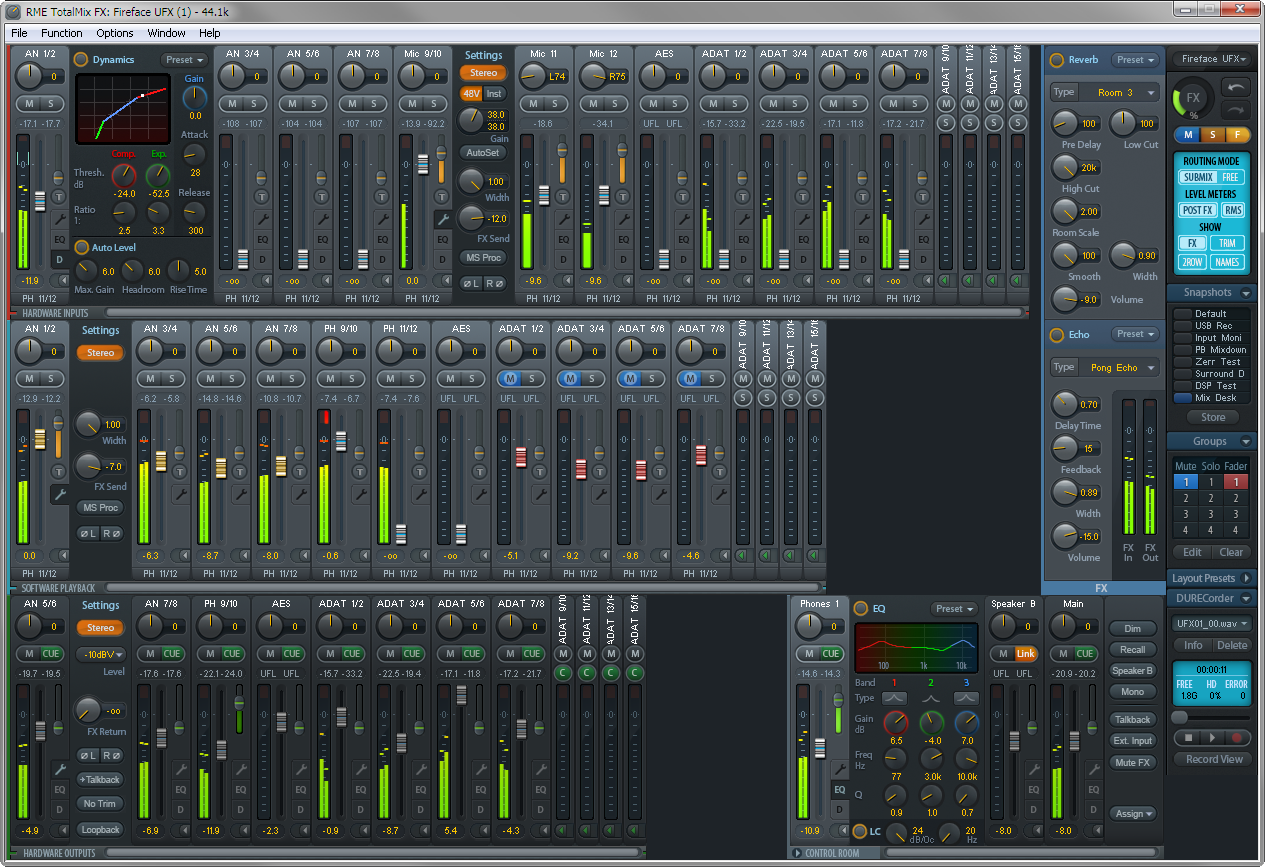
Any overview of any RME interface would not be complete without mentioning TotalMix FX, RME’s comprehensive routing and mixing control software. TotalMix essentially turns the UFX II into a full-blown digital mixing desk, complete with EQ, Reverb/Delay and Compression on every channel.
Each channel features an independent EQ and compression section, M/S processing and phase invert, along with stereo reverb and delay effects sends. TotalMix provides further functionality too, such as grouping faders for level control, soloing and muting, as well as enabling any of the Fireface UFX II's channels to be routed to one another with zero latency.
In this way, different monitoring mixes can be created for musicians, removing the need for any external effects. The effects are primarily designed to be used for monitoring, so only the dry signal will be recorded by default. It’s simple enough however to record a wet mix, using TotalMix FX’s Loopback function. In this way, you could print a live show you’ve mixed and recorded straight to a CD, to be sold to fans right after a show has finished!
DURec – Direct USB Recording
One of the most unique functions of the original UFX was the DURec feature. DURec stands for Direct USB Recording, and allows for all channels to be recorded directly to a thumb drive or external hard drive via the USB port found on the front of the device, turning the UFX into a standalone hard disk recorder and playback device. Alternatively, you can also use DURec to simultaneously make a backup multi-track recording of your session. If you suddenly have an unexpected issue with your computer during a take, no problem – that perfect performance will still be saved, thanks to DURec.
The Fireface UFX II’s DURec functionality has been improved compared to the original UFX – this second generation hardware offers better functionality, compatibility and reliability, even with slower or multi-partitioned USB hard drives. Audio files can also now be time-stamped, meaning that each sound file contains accurate timecode information (stored as a BWAV file), which provides seamless playback of tracks in every project.
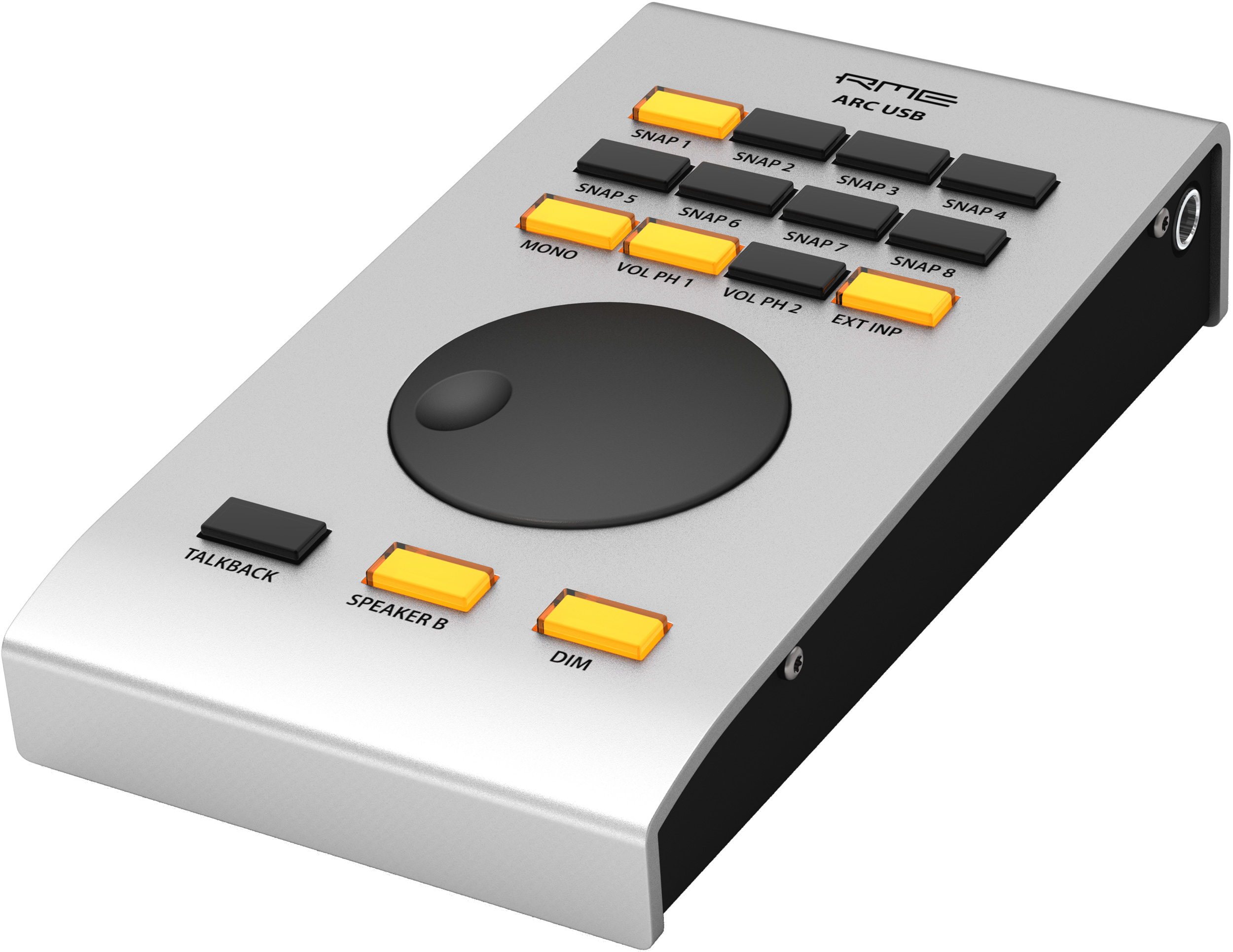 Advanced Remote Control USB (ARC USB)
Advanced Remote Control USB (ARC USB)
The Fireface UFX II also has a USB port for connecting the new RME ARC USB, the advanced remote control. The original ARC was a beautiful piece of German engineering which provided users with all of the main functions of their interface right at their fingertips. Although it's now been discontinued, it will be replaced by the upcoming ARC USB, which features more buttons (freely assignable) which now light up too.
The ARC USB can be connected to a Mac or PC’s USB port, or directly to the Fireface UFX II itself. Also the UFX II features front panel controls, the ARC USB provides quicker and easier access for control over the UFX II when recording in standalone mode. The programmable function keys can be mapped to control a wide variety of commands in TotalMix FX. Levels, gains, groups, submixes and effects, as well as preset recall, A/B speaker switching, talkback, dim, mono and many more features can be controlled directly from the USB remote.
Flexibility, compatibility and reliability
To summarise, the RME Fireface UFX II features everything an audio engineer needs to record and mix high-quality audio. Whether you’re in the studio or out on the road, the sound quality and routing flexibility makes the UFX II an incredibly powerful central hub for your music production setup. The USB 2 connection means you can use the interface with pretty much any Mac or PC currently available (along with an iPad running in Class Compliant mode), and will likely remain a common format for many years to come. The DURec feature gives you an incredible failsafe for creating a backup recording, and gives you the option of recording and playing back tracks without a computer. With a combination of pristine sonics, incredible functionality and a competitive price-point, the Fireface UFX II builds upon the legacy of its predecessor whilst providing the best RME sound quality to date.
Find out more about the RME Fireface UFX II
Find out more about the RME Fireface UFX+
Find out more about the RME MADIface Pro
![]() The RME Fireface UFX II is expected to ship sometime in the first quarter of 2017. If you'd like to know more, give us a call on 01727 821 870 to speak to one of our team or to arrange a demo. You can also contact us via the web here.
The RME Fireface UFX II is expected to ship sometime in the first quarter of 2017. If you'd like to know more, give us a call on 01727 821 870 to speak to one of our team or to arrange a demo. You can also contact us via the web here.



















